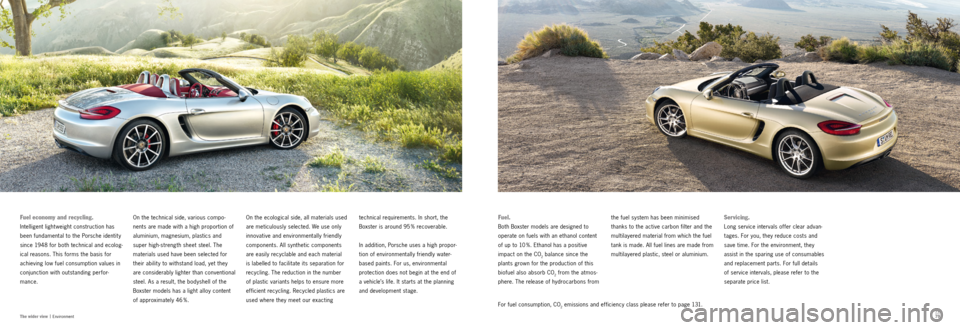fuel filter PORSCHE BOXSTER S 2013 3.G Information Manual
[x] Cancel search | Manufacturer: PORSCHE, Model Year: 2013, Model line: BOXSTER S, Model: PORSCHE BOXSTER S 2013 3.GPages: 69, PDF Size: 13.64 MB
Page 40 of 69

7879For fuel consumption, CO2 emissions and efficiency class please refer to page 131.
The wider view |
Environment
Servicing.
Long service intervals offer clear advan -
tages. For you, they reduce costs and
save time. For the environment, they
assist in the sparing use of consumables
and replacement parts. For full details
of service intervals, please refer to the
separate price list.
the fuel system has been minimised
thanks to the active carbon filter and the
multilayered material from which the fuel
tank is made. All fuel lines are made from
multilayered plastic, steel or aluminium.
Fuel.
Both
Boxster models are designed to
operate on fuels with an ethanol content
of up to 10 %. Ethanol has a positive
impact on the CO
2 balance since the
plants grown for the production of this
biofuel also absorb CO
2 from the atmos -
phere. The release of hydrocarbons from
technical requirements. In short, the
Boxster is around 95 % recoverable.
In addition, Porsche uses a high propor -
tion of environmentally friendly water-
based paints. For us, environmental
protection does not begin at the end of
a vehicle’s life. It starts at the planning
and development stage.
On the ecological side, all materials used
are meticulously selected. We use only
innovative and environmentally friendly
components. All synthetic components
are easily recyclable and each material
is labelled to facilitate its separation for
recycling. The reduction in the number
of plastic variants helps to ensure more
ef ficient recycling. Recycled plastics are
used where they meet our exacting
On the technical side, various compo
-
nents are made with a high proportion of
aluminium, magnesium, plastics and
super high-strength sheet steel. The
materials used have been selected for
their abilit y to withstand load, yet they
are considerably lighter than conventional
steel. As a result, the bodyshell of the
Boxster models has a light alloy content
of approximately 46 %.
Fuel economy and recycling.
Intelligent lightweight construction has
been fundamental to the Porsche identit y
since 1948 for both technical and ecolog -
ical reasons. This forms the basis for
achieving low fuel consumption values in
conjunction with outstanding perfor -
mance.